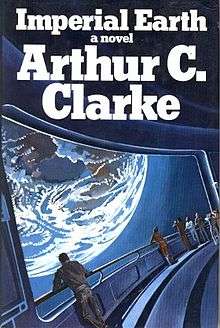Imperial Earth
 Cover of the first edition | |
| Author | Arthur C. Clarke |
|---|---|
| Country | United Kingdom |
| Language | English |
| Genre | Science fiction |
| Publisher | Gollancz |
Publication date | 1975 |
| Media type | Print (Hardback & Paperback) |
| ISBN | 0-575-02011-3 |
| OCLC | 2966514 |
| 823/.9/14 | |
| LC Class | PZ3.C551205 Im PR6005.L36 |
Imperial Earth is a science fiction novel written by Arthur C. Clarke, and published in time for the U.S. bicentennial in 1976 by Ballantine Books. The plot follows the protagonist, Duncan Makenzie, on a trip to Earth from his home on Titan, ostensibly for a diplomatic visit to the U.S. for its 500th birthday, but really in order to have a clone of himself produced.
Plot summary
Duncan Makenzie is the latest generation of the 'first family' of Titan, a colonised moon of Saturn. Originally settled by his grandfather Malcolm Makenzie in the early 23rd century, Titan's economy has flourished based on the harvest and sale of hydrogen mined from the atmosphere, which is used to fuel the fusion engines of interplanetary spacecraft.
As the plot opens in 2276, a number of factors are combining to make a diplomatic visit to the 'mother world' of Earth a necessity. Firstly, the forthcoming 500th anniversary of US Independence, which is bringing in colonists from the entire Solar System, obviously needs a suitable representative from Titan. Secondly, the Makenzie family carry a fatal damaged gene that means any normal continuation of the family line is impossible — so both Duncan and his "father" Colin are clones of his "grandfather" Malcolm. Human cloning is a mature technology but is even at this time ethically controversial. And thirdly, technological advances in spacecraft drive systems — specifically the 'asymptotic drive' which improves the fuel efficiency by orders of magnitude — means that Titan's whole economy is under threat as the demand for hydrogen is about to collapse.
The human aspects of the tale center mainly on the intense infatuation (largely unrequited but not unconsummated) that the two main male characters, Duncan and Karl Helmer, develop for the vividly characterized Catherine Linden Ellerman (Calindy), a visitor to Titan from Earth in their youth, and its lifelong consequences.
A number of other sub-plots suggest some sort of greater mystery, but remain unexplored. The book ends with him returning home with his new "child" Malcolm (who is a clone of his dead friend Karl), leaving the other plot threads dangling.
Major themes
The puzzle game Pentominos features in a prominent subplot of the novel.
The book offers socially liberal ideas about sexuality and racial attitudes. For example, Duncan Makenzie is dark brown. His colour is not mentioned until approximately halfway through the book; his race is no more significant to him than his hair colour. At several points Makenzie also reminisces about sexual affairs with males, and that bisexuality is now considered the norm. Exclusive heterosexuality or homosexuality is not generally practiced.
Clarke describes in great detail throughout the book a personal communications device called a 'minisec' combining mobile video phone and PDA with global data connectivity. He also describes a larger desk 'comsole' or communications console giving similar access to global information services.
However, the major theme of the novel is the nature of change and transition. For Titan it stands on a precipice of transition; it can either fall into the past with the demise of hydrogen and become "decadent" like Earth or become the beginning of a new and uncertain frontier. Karl is obsessed with preserving the past in his relationships and Duncan himself is the preservation of his grandfather, which Duncan ultimately ends with the cloning of Karl.
Editions
The original UK hardcover edition (ISBN 0-575-02011-3) has the subtitle "A Fantasy of Love and Discord" and has 38 chapters and "Acknowledgments and Notes". The later US hardcover edition adds a quote from Ernest Hemingway, has 43 chapters, drops the subtitle, and expands the Acknowledgements and Notes. The later US paperback edition also features an "Additional Note" about a possible biological error in the plot.
External links
- Imperial Earth title listing at the Internet Speculative Fiction Database